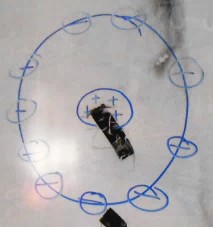การพัฒนาความเข้าใจธรรมชาติของวิทยาศาสตร์ของนักเรียนห้องเรียนพิเศษวิทยาศาสตร์ชั้นมัธยมศึกษาปีที่ 4 ในหน่วยการเรียนรู้เรื่องโครงสร้างอะตอม
Main Article Content
Abstract
Napaksorn Sangwanpetch, Chatree Faikhamta and Apisit Songsasen
รับบทความ: 25 กันยายน 2559; ยอมรับตีพิมพ์: 30 พฤษภาคม 2560
บทคัดย่อ
งานวิจัยนี้มีจุดประสงค์เพื่อศึกษาแนวทางการจัดการเรียนรู้ธรรมชาติของวิทยาศาสตร์แบบชัดแจ้งร่วมกับการสะท้อนความคิดในเนื้อหาโครงสร้างอะตอม และศึกษาความเข้าใจธรรมชาติของวิทยาศาสตร์ของนักเรียนห้องเรียนพิเศษวิทยาศาสตร์ ชั้นมัธยมศึกษาปีที่ 4 จำนวน 25 คน จากโรงเรียนของรัฐบาลแห่งหนึ่งในเขตกรุงเทพมหานคร ภาคเรียนที่ 2 ปีการศึกษา 2557 โดยเน้นศึกษาธรรมชาติของวิทยาศาสตร์ 6 ประเด็น ได้แก่ (1) ความรู้วิทยาศาสตร์มีพื้นฐานมาจากหลักฐานเชิงประจักษ์ (2) การเปลี่ยนแปลงของความรู้วิทยาศาสตร์ (3) บทบาทของความคิดสร้างสรรค์และจินตนาการต่อวิทยาศาสตร์ (4) ทฤษฎีวิทยาศาสตร์ (5) วิธีการได้มาซึ่งความรู้วิทยาศาสตร์ และ (6) การสังเกตและลงข้อสรุป เก็บข้อมูลโดยใช้บันทึกวิดีโอ บันทึกการจัดการเรียนรู้ ใบกิจกรรมของนักเรียน และแบบวัดความเข้าใจธรรมชาติของวิทยาศาสตร์คำถามปลายเปิดร่วมกับการสัมภาษณ์กึ่งโครงสร้าง ผลการวิจัยพบว่า แนวทางการจัดการ เรียนรู้ธรรมชาติของวิทยาศาสตร์แบบชัดแจ้งร่วมกับการสะท้อนความคิดในเนื้อหาโครงสร้างอะตอมที่มีประสิทธิภาพมีลักษณะดังนี้ (1) สร้างประสบการณ์ให้นักเรียนพัฒนาแบบจำลองอะตอมร่วมกับการอภิปรายและสะท้อนความคิดเกี่ยวกับธรรมชาติของวิทยาศาสตร์ที่แฝงอยู่ในแบบจำลองอะตอมของนักเรียน (2) ใช้คำถามอภิปรายที่จำเพาะเจาะจงกับกิจกรรมพัฒนาแบบจำลองอะตอมเพื่อสื่อถึงประเด็น ธรรมชาติของวิทยาศาสตร์ และเปิดโอกาสให้นักเรียนสะท้อนความคิด (3) นำประวัติศาสตร์การพัฒนาแบบจำลองอะตอมของดอลตัน ทอมสัน รัทเทอร์ฟอร์ด โบร์ และกลุ่มหมอก ให้นักเรียนศึกษาร่วมกับการอภิปรายและสะท้อนความคิดเกี่ยวกับธรรมชาติของวิทยาศาสตร์ที่แฝงอยู่ในประวัติศาสตร์ หลังเสร็จสิ้นการจัดการเรียนรู้ดังกล่าว พบว่า นักเรียนส่วนใหญ่เข้าใจธรรมชาติของวิทยาศาสตร์ถูกต้องใน 3 ประเด็น คือ ประเด็นบทบาทของหลักฐานต่อการพัฒนาความรู้วิทยาศาสตร์ การเปลี่ยนแปลงของความรู้วิทยาศาสตร์ และหน้าที่ของทฤษฎีวิทยาศาสตร์ ผลการวิจัยนี้สนับสนุนว่าการจัดการเรียนรู้แบบชัดแจ้งร่วม กับการสะท้อนความคิดสามารถพัฒนาความเข้าใจธรรมชาติของวิทยาศาสตร์ให้กับนักเรียนได้
คำสำคัญ: ธรรมชาติของวิทยาศาสตร์ นักเรียนห้องเรียนพิเศษวิทยาศาสตร์ โครงสร้างอะตอม
Abstract
This research aimed at examining how to teach explicit and reflective approach in the unit of atomic structure and investigating 25 tenth-grade science-gifted students’ understanding of the nature of science (NOS) in a public secondary school in Bangkok, in second semester of academic year 2014. The study emphasized six aspects of the NOS including (1) empirical (2) tentative (3) creativity and imagination (4) scientific theory (5) scientific methods and (6) observation and inference. The data were collected through video recordings, learning records, students’ worksheets, and an open-ended questionnaire, in conjunction with semi-structured interview. Results indicated that the effective ways of explicit and reflective approach in the unit of atomic structure were: (1) providing students with concrete experiences to develop atomic model that can be explicit and reflective in their atomic model, (2) using specific questions with the developing atomic model activities to convey the NOS aspects and giving the opportunity which students reflected their opinions, and (3) using histories about the development of Dalton, Thomson, Rutherford, Bohr and Cloud electron’s atomic models which students would learn these histories with explicit and reflective ways. By the end of the intervention, the majority of students held informed understanding of the three NOS aspects including the empirical, the tentative and the scientific theory’s role. These findings supported that explicit and reflective learning approach can improve students’ understanding of the NOS.
Keywords: Nature of science, Science-gifted students, Atomic structure
Downloads
Article Details

This work is licensed under a Creative Commons Attribution-NonCommercial 4.0 International License.
References
Abd-El-Khalick, F., and Lederman, N. G. (2000). Improving science teachers' conceptions of nature of science: A critical review of the literature. International Journal of Science Education 22(7): 665–701.
American Association for the Advancement of Science [AAAS]. (1989). Project 2061: Science for All Americans. New York: Oxford University.
Chamrat, S. (2009). Exploring Thai Grade 10 Chemistry Students’ Understanding of Atomic Structure Concepts and the Nature of Science through the Model-based Approach. Doctor of Philosophy Thesis in Science Education. Bangkok: Kasetsart University.
Chamrat, S., Yutakom, N., and Chaiso, P. (2009). Grade 10 science students’ understanding of the nature of science. KKU Research Journal 14(4): 360–374.
Irwin, A. R. (2000). Historical case studies: Teaching the nature of science in context. Science and Education 84(1): 5–26.
Kemmis, S. and McTaggart, R. (1988). The Action Research Planner. 3rd ed. Australia: Deakin University.
Khishfe, R. (2008). The development of seventh graders' views of nature of science. Journal of Research in Science Teaching 45(4): 470–496.
Khishfe, R. and Abd-El-Khalick, F. (2002). Influence of explicit and reflective versus implicit inquiry-oriented instruction on sixth graders’ views of nature of science. Journal of Research in Science Teaching 39(7): 551–578.
Khishfe, R. and Lederman, N. G. (2006). Teaching nature of science within a controversial topic: Integrated versus nonintegrated. Journal of Research in Science Teaching 43(4): 377–394.
Khishfe, R. and Lederman, N. G. (2007). Relationship between instructional context and views of nature of science. International Journal of Science Education 29(8): 939–961.
Kijkuakul, S., Yutakom, N., and Engkagul, A. (2005). Grade 11 students’ understandings about the nature of science. Kasetsart Journal of Social Science 26(2): 133–145.
Ladachart, L., and Suttakun, L. (2012). Exploring and developing tenth-grade students’ understandings of nature of science. Princess of Naradhiwas University Journal 4(2): 73–90.
Lederman, N. G., Abd-El-Khalick, F., Bell, R. L., and Schwartz, R. S. (2002). View of nature of science questionnaire: Toward valid and meaningful assessment of learners' conceptions of nature of science. Journal of Research in Science Teaching 39(6): 497–521.
Liangkrilas, J. (2009). Development of Level 4 Biology Students’ Understanding of the Nature of Science in the Context of the Unit on Respiration: Explicit and Reflective Inquiry-based Approach. Doctor of Philosophy Thesis in Science Education. Bangkok: Kasetsart University.
Lin, H. S., and Chen, C. C. (2002). Promoting preservice chemistry teachers’ understanding about the nature of science through history. Journal of Research in Science Teaching 39(9): 773–792.
Mahalee, K. (2010). The Development of Seventh Grade Students’ Understanding of Nature of Science through Reflective Explicit Instructional Approach. Master of Education Thesis in Science Education. Bangkok: Kasetsart University.
McComas, W. F. (1998). The principal elements of the nature of science: Dispelling the myths. In McComas, W. F. (Ed.). The Nature of Science in Science Education. Netherlands: Kluwer Academic.
Panyo, P., and Faikhamta, C. (2016). The development of grade-11 students’ understanding of the nature of science using explicit and reflective approach in the unit of solid, liquid and gas. Journal of Research Unit on Science, Technology and Environment for Learning 7(2): 265–284.
Pattamapongsa, A. (2012). The Development of High School Student’s Conception of Photosynthesis and Views of Nature of Science Using Inquiry-Based/Explicit NOS Approach. Master of Education Thesis in Science Education. Bangkok: Kasetsart University.
Yacoubian, H. A., and BouJaoude, S. (2010). The effect of reflective discussions following inquiry-based laboratory activities on students' views of nature of science. Journal of Research in Science Teaching 47(10): 1229–1252.
